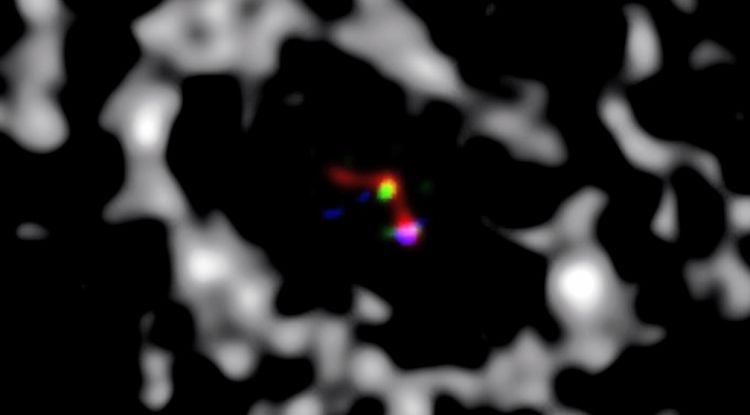Using telescopes in North and South America, University of Arizona astronomers have taken the first images of planets in formation around a distant star.
In addition to the sheer thrill of capturing the first images of planets being born, the imaging of three planets around a star 450 light-years away will help define theories of solar system formation, said Stephanie Sallum, a graduate student at the UA Department of Astronomy and Steward Observatory.
It’s also a testament to advances in technology that allow astronomers to differentiate objects so close together in the sky that it is akin to observing “the head of a pin a kilometer away,” Sallum said.
The feat was enabled by adaptive optics systems on the Large Binocular Telescope on Mount Graham near Safford in Arizona and the Magellan Telescope near La Silla, Chile.
Both telescopes use flexible secondary mirrors built at the UA and outfitted by optical scientists at Arcetri Observatory in Italy with devices that measure the distortion caused by the atmosphere and bend the mirror to erase the blurring those distortions caused.
The planets were imaged in separate studies conducted by Sallum on the Large Binocular Telescope and Kate Follette, with the MagAO (Magellan Adaptive Optics) team in Chile.
Follette, now a research scientist with the Gemini Planet Imager team at Stanford University, was part of a team led by UA astronomer Laird Close that developed MagAO for the 6.5-meter Magellan Telescope at the Carnegie Institution’s Las Campanas Observatory in Chile.
She was performing a survey of cleared-out sections of dust disks around stars when she found and imaged an object using a visible light camera on the Magellan and filtered it for the spectral signature of hot gas falling onto the forming planet — a characteristic signature of hydrogen known as H-Alpha.
One image is not proof, Follette said, though the H-Alpha signature is “pretty bulletproof” evidence of a forming planet. She originally thought she would have to wait for a future observing run to confirm the discovery and write it up for publication. Then she heard about Sallum’s work during a conference at Biosphere 2 in Oracle.
“It was pretty serendipitous,” Follette said.
“I thought we’d have to sit on it for a year. Then I went to a talk by Steph and she had observed the same thing. At that point we had two very different observations and proof that it’s real.”
Sallum had used the two 8-meter eyes of the Large Binocular Telescope to observe the gap in the dust disk around the star in the mid-infrared wavelengths of light. She spotted three objects, including the one Follette had imaged in visible light.
The two joined forces on the subsequent paper, “Accreting protoplanets in the LkCa 15 transition disk,” which was published Thursday in the journal Nature.
Sallum’s adviser Josh Eisner, a co-author on the paper, said direct imaging of planets is a difficult task. Astronomers have found nearly 1,900 exoplanets, but their existence has been calculated mainly by the dimming caused by planets passing in front of their stars or by the gravitational wobble they cause. Fewer than 20 have been directly imaged and none were planets in formation.
For most telescopes, the stars are too big and bright and the planets too small and dim to image.
Eisner said the discovery is a good demonstration of the importance of adaptive optics and Arizona’s role in developing it.
“The whole AO group at Arizona pretty much is involved. It’s definitely an Arizona effort and a very nice success story of collaboration,” he said.
Close, who is in Chile this month for an observing run on Magellan, said by email that looking for “forming planets in the special dark red light given off by hydrogen gas” had been a primary goal when he set out to develop an adaptive-optics system with a visible light camera.
“Thanks to Kate and the MagAO team we have our first glimpses of how planets form, we now know that they have strong magnetic fields, and that they ‘eat’ a stream of hydrogen gas from the disk around their parent star and glow brightly during that ‘growth spurt.’ That is a lot to learn all at once about how gas giant planets form,” Close wrote.





